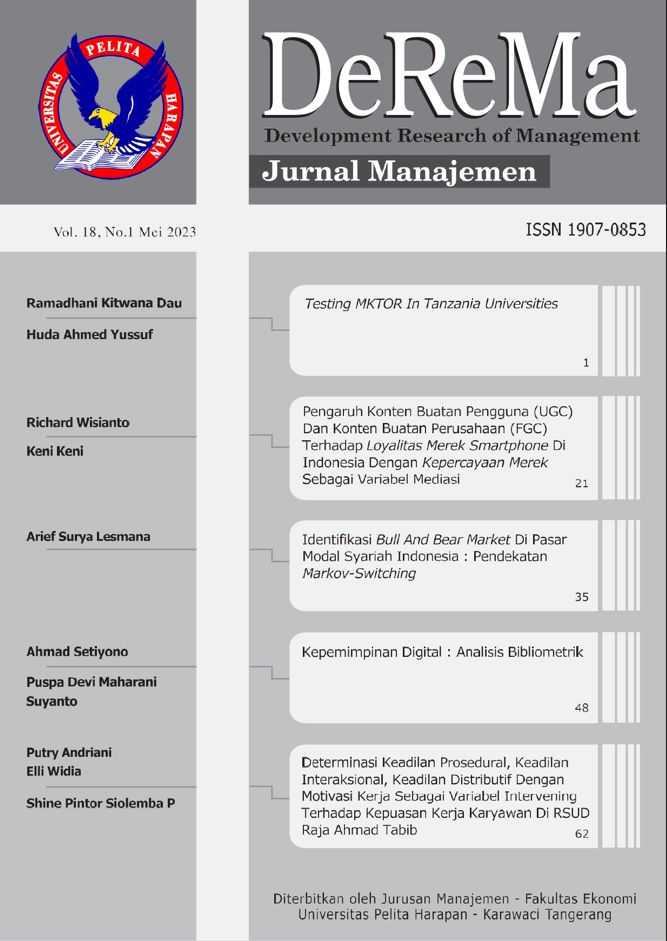PENGARUH KONTEN BUATAN PENGGUNA (UGC) DAN KONTEN BUATAN PERUSAHAAN (FGC) TERHADAP LOYALITAS MEREK SMARTPHONE DI INDONESIA DENGAN KEPERCAYAAN MEREK SEBAGAI VARIABEL MEDIASI [THE INFLUENCE OF USER-PRODUCED CONTENT (UGC) AND COMPANY-PRODUCED CONTENT (FGC) ON SMARTPHONE BRAND LOYALTY IN INDONESIA WITH BRAND TRUST AS A MEDIATION VARIABLE]
DOI:
https://doi.org/10.19166/derema.v18i1.6464Keywords:
user generated content, company generated content, brand trust, brand loyalty, konten yang dibuat pengguna, konten yang dibuat perusahaan, kepercayaan merek, loyalitas merekAbstract
This study aims to determine the mediating role of brand trust in the influence of user generated content and firm generated content on smartphone X brand loyalty in Indonesia. In previous studies, there were different results related to the influence of user generated content and firm generated content, so this study was conducted to review these two variables in influencing brand loyalty to the X smartphone brand. Data were collected cross-sectionally using a digitally distributed questionnaire to 175 respondents who are customers of smartphone brand X. Sample selection by purposive sampling. Furthermore, the data was analyzed using Partial Least Squares-Structural Equation Modeling (PLS-SEM) through the SmartPLS software. This study shows that user generated content (UGC) and firm generated content (FGC) have a positive and significant effect on brand trust and brand loyalty. However, brand trust did not significantly mediate the effect of UGC on brand loyalty, but was able to significantly mediate the effect of FGC on brand loyalty. These results imply that when customers trust a smartphone brand X, this trust is based on promotional content created by smartphone companies which can then increase customer loyalty to that brand.
Abstrak dalam Bahasa Indonesia. Penelitian ini bertujuan untuk mengetahui peran mediasi kepercayaan merek pada pengaruh konten yang dibuat oleh pengguna dan konten yang dibuat oleh perusahaan terhadap loyalitas merek smartphone X di Indonesia. Dalam penelitian sebelumnya menunjukan terdapat hasil yang berbeda terkait pengaruh konten buatan pengguna dan konten buatan perusahaan, sehingga penelitian ini dilakukan untuk meninjau kedua variabel tersebut dalam mempengaruhi loyalitas merek pada merek smartphone X. Data dikumpulkan secara cross sectional dengan menggunakan kuesioner yang disebarkan secara digital kepada 175 responden yang merupakan pelanggan merek smartphone X. Pemilihan sampel dengan purposive sampling. Selanjutnya, data tersebut dianalisis dengan menggunakan Partial Least Squares-Structural Equation Modeling (PLS-SEM) melalui software SmartPLS. Penelitian ini menunjukkan bahwa konten buatan pengguna (UGC) dan konten buatan perusahaan (FGC) berpengaruh positif dan signifikan terhadap kepercayaan merek dan loyalitas merek. Namun, kepercayaan merek tidak memediasi secara signifikan pengaruh UGC terhadap loyalitas merek, tetapi mampu memediasi secara signifikan pengaruh FGC terhadap loyalitas merek. Hasil tersebut mengimplikasikan bahwa ketika pelanggan percaya dengan suatu merek smartphone X, kepercayaan tersebut didasari oleh konten promosi yang dibuat oleh perusahaan smartphone yang kemudian dapat meningkatkan kesetiaan pelanggan terhadap merek tersebut.
References
Alfianto, R. (2022). Mulai Dicari, Ini Daftar Smartphone 5G Paling Diminati di E-Commerce. www.jawapos.com. Retrieved from https://www.jawapos.com/oto-dan-tekno/gadget/27/07/2022/mulai-dicari-ini-daftar-smartphone-5g-paling-diminati-di-e-commerce/
Assaker, G., O’Connor, P., & El-Haddad, R. (2020). Examining an integrated model of green image, perceived quality, satisfaction, trust, and loyalty in upscale hotels. Journal of Hospitality Marketing and Management, 29(8), 934-955. https://doi.org/10.1080/19368623.2020.1751371
Atulkar, S. (2020). Brand trust and brand loyalty in mall shoppers. Marketing Intelligence and Planning, 38(5), 559-572. https://doi.org/10.1108/MIP-02-2019-0095
Boonghee, Y., Naveen, D., & Sungho, L. (2000). An Examination of Selected Marketing Mix Elements and Brand Equity. Journal of the Academy of Marketing Science, 28(2), 195-211. https://link.springer.com/content/pdf/10.1177/0092070300282002.pdf
Bruns, A. (2016). The International Encyclopedia of Communication Theory and Philosophy. John Wiley & Sons.
Ceballos, M., Crespo, Ã. G., & Cousté, N. L. (2016). Impact of Firm-Created Content on User-Generated Content: Using a New Social Media Monitoring Tool to Explore Twitter. Developments in Marketing Science: Proceedings of the Academy of Marketing Science, 303-306. https://doi.org/10.1007/978-3-319-29877-1_61
Chen, Z. F., & Cheng, Y. (2020). Consumer response to fake news about brands on social media: the effects of self-efficacy, media trust, and persuasion knowledge on brand trust. Journal of Product and Brand Management, 29(2), 188-198.
Cheng, Y., Jin, Y., Hung-Baesecke, C. J. F., & Chen, Y. R. R. (2019). Mobile Corporate Social Responsibility (mCSR): Examining Publics’ Responses to CSR-Based Initiatives in Natural Disasters. International Journal of Strategic Communication, 13(1), 76-93. https://doi.org/10.1080/1553118X.2018.1524382
CNN Indonesia. (2022). E-Commerce Rajai Pertumbuhan Ekonomi Digital Saat Pandemi. www.cnnindonesia.com. Retrieved from https://www.cnnindonesia.com/ekonomi/20220615082930-92-809094/e-commerce-rajai-pertumbuhan-ekonomi-digital-saat-pandemi
Eraspace. (2021). Mengenal Teknologi Digital yang Semakin Tren di Abad 21. eraspace.com. Retrieved from https://eraspace.com/artikel/post/mengenal-5-teknologi-digital-yang-semakin-tren-di-abad-21
Heng Wei, L., Chuan Huat, O., & Arumugam, P. V. (2022). Social media communication with intensified pandemic fears: Evaluating the relative impact of user- and firm-generated content on brand loyalty. Asia-Pacific Journal of Business Administration. https://doi.org/10.1108/APJBA-07-2021-0319
Hermaren, V., & Achyar, A. (2018). The effect of firm created content and user generated content evaluation on customer-based brand equity. INOBIS: Jurnal Inovasi Bisnis dan Manajemen Indonesia, 2(1), 86-100. https://doi.org/10.31842/jurnal-inobis.v2i1.63
Ibrahim, B., Aljarah, A., & Sawaftah, D. (2021). Linking social media marketing activities to revisit intention through brand trust and brand loyalty on the coffee shop facebook pages: Exploring sequential mediation mechanism. Sustainability (Switzerland), 13(4), 1-16. https://doi.org/10.3390/su13042277
Jacoby, J. (1971). A Model of Multibrand Loyalty. Journal of Advertising Research, 26, 25-31.
Kataria, S., & Saini, V. (2019). The mediating impact of customer satisfaction in relation of brand equity and brand loyalty: An empirical synthesis and re-examination. South Asian Journal of Business Studies, 9(1), 62-87. https://doi.org/10.1108/SAJBS-03-2019-0046
Kaur, H., & Soch, H. (2018). Satisfaction, trust and loyalty: Investigating the mediating effects of commitment, switching costs and corporate image. Journal of Asia Business Studies, 12(4), 361-380. https://doi.org/10.1007/978-3-030-15346-5
Keller, K. L., & Aaker, D. A. (1992). The Effects of Sequential Introduction of Brand Extensions. Journal of Marketing Research, 29(1), 35. https://doi.org/10.2307/3172491
Kemdikbud. (2022). Membangun Bisnis di Era Digital. lldikti5.kemdikbud.go.id. Retrieved from https://lldikti5.kemdikbud.go.id/home/detailpost/membangun-bisnis-di-era-digital
Keni, & Putra. (2018). Factor Influencing Brand Loyalty in The Indonesian Food and Beverage Sector. Jurnal Muara, 2(2), 5671747.
Keni, & Kristiawan. (2020). Pengaruh Packaging, Social Media Marketing dan Electronic Word of Mouth Terhadap Keputusan Pembelian Busana Brand Lokal. DeReMa (Development of Research Management), 15(2), 245. https://doi.org/10.19166/derema.v15i2.2445
Keni, & Japiana, M. (2022). Factor Influencing Brand Loyalty In The Indonesian Food And Beverage Sector. Jurnal Manajemen, 26(2), 277-295. https://doi.org/10.24912/jm.v26i2.980
Lassar, W. M., Mittal, B., & Sharma, A. (1995). Measuring customer”based brand equity. Journal of Consumer Marketing, 12(4), 11-19.
Luca, M. (2015). User-Generated Content and Social Media in Handbook of Media Economics, (Vol. 1,. 563-592). Elsevier B.V. https://doi.org/10.1016/b978-0-444-63685-0.00012-7
Mazzucchelli, A., Chierici, R., Ceruti, F., Chiacchierini, C., Godey, B., & Pederzoli, D. (2018). Affecting brand loyalty intention: The effects of UGC and shopping searches via Facebook. Journal of Global Fashion Marketing, 9(3), 270-286. https://doi.org/10.1080/20932685.2018.1461022
Mehrabian, A., & Russell, J. A. (1974). An approach to environmental psychology. In An approach to environmental psychology. The MIT Press.
Meire, M., Hewett, K., Ballings, M., Kumar, V., & Van den Poel, D. (2019). The Role of Marketer-Generated Content in Customer Engagement Marketing. Journal of Marketing, 83(6), 21-42. https://doi.org/10.1177/0022242919873903
Melián-Alzola, L., & MartÃn-Santana, J. D. (2020). Service quality in blood donation: Satisfaction, trust and loyalty. Service Business, 14(1), 101-129. https://doi.org/10.1007/s11628-019-00411-7
Poulis, A., Rizomyliotis, I., & Konstantoulaki, K. (2019). Do firms still need to be social? Firm generated content in social media. Information Technology and People, 32(2), 387-404. https://doi.org/10.1108/ITP-03-2018-0134
Putri, A. D. E., Indarini, & Anandya, D. (2019). The influence of Brand Awareness, Brand Image, and Brand Trust on Brand Loyalty. Proceedings of the 16th International Symposium on Management (INSYMA 2019), XXIV(03), 412-426. https://doi.org/10.2991/insyma-19.2019.31
Schivinski, B., & Dabrowski, D. (2016). The effect of social media communication on consumer perceptions of brands. Journal of Marketing Communications, 22(2), 189-214. https://doi.org/10.1080/13527266.2013.871323
Singh, M., & Matsui, Y. (2017). How long tail and trust affect online shopping behavior: an extension to UTAUT2 framework. Pacific Asia Journal of the Association for Information Systems, 9(4), 1-24. https://doi.org/10.17705/1pais.09401
Downloads
Published
Issue
Section
License
Authors who publish with this journal agree to the following terms:
1) Authors retain copyright and grant the journal right of first publication with the work simultaneously licensed under a Creative Commons Attribution License (CC-BY-SA 4.0) that allows others to share the work with an acknowledgement of the work's authorship and initial publication in this journal.
2) Authors are able to enter into separate, additional contractual arrangements for the non-exclusive distribution of the journal's published version of the work (e.g., post it to an institutional repository or publish it in a book), with an acknowledgement of its initial publication in this journal.
3) Authors are permitted and encouraged to post their work online (e.g., in institutional repositories or on their website). The final published PDF should be used and bibliographic details that credit the publication in this journal should be included.





